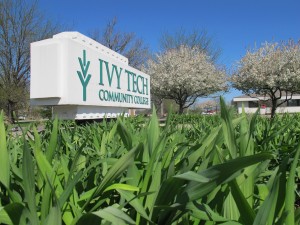Why Colleges Keep Building Even When Money's Tight

Kyle Stokes / StateImpact Indiana
Ivy Tech in Anderson. The statewide community college system has needed to keep building as enrollment has skyrocketed.
There’s another debt crisis brewing in U.S. universities — and this one has little to do with the nation’s burgeoning student loan burden.
University buildings are aging, enrollments are increasing and state funding for new facilities is drying up. That means, as Inside Higher Ed reports, universities are more likely to go into debt to finance their next building project.
Indiana has seen this up close, as the state’s colleges scramble to open new learning spaces or raise fees to maintain old ones.
“Public universities have and will continue to turn to the debt market to fund capital projects, driving debt for public universities higher for the foreseeable future, and prolonging a long-term trend established over the past decade,” Edith Behr, vice president and senior credit officer for Moody’s Investors Service’s public finance group, wrote in a report in March calling attention to potential growth in debt for public colleges and universities.
Burdened by aging campuses, several years of backlogged maintenance projects, increased competition for students (and the tuition revenue that comes with them), and little hope that states are going to fund the construction they need, either through appropriations or by issuing their own debt, public colleges and universities are likely to issue their own debt to finance the renovation of their facilities — a change that moves public institutions closer to their private counterparts, could change what institutions build and repair, and could pass more costs on to students.
Already, Indiana University has passed some of those costs directly to students. Faced with cuts to state funding for renovating and rehabilitating buildings, IU started charging a mandatory student fee this year to help the school make a dent in a $600 million backlog of repair and maintenance projects.
Ivy Tech Community College has faced chronic space shortages as enrollment has boomed over the years. But, officials at the statewide community college say, facilities have continually been an issue. From a recent Ivy Tech report:
While the College’s new and recently remodeled facilities are aesthetically pleasing, efficient and functional, there are numerous examples of substandard and inadequate facilities in the system… Some facilities have been provided to the College at little or no cost as an incentive for the College to offer courses and services in a community. The College leases spaces in some communities, with some of this space providing a substandard learning environment for a comprehensive community college.
Having a large number of relatively small facilities located throughout Indiana… [is] very inefficient and, therefore, very expensive to operate. In addition, since many of these facilities serve a relatively small number of students, they are not able to provide a full range of courses or services that would normally be expected of a comprehensive community college.
Ivy Tech has made attempts to alleviate the pressure of increasing enrollments on its limited space by renting trailers for classroom space. The college announced last week it will purchase land near adjacent to its Lafayette campus as part of its plans for a $25 million campus expansion. Broadly, however, university officials say limited state funding could make addressing issues with facilities difficult.
But, The Hechinger Report says, many universities are still building:
An unprecedented multibillion-dollar building boom is under way at U.S. universities and colleges—despite budget shortfalls, endowment declines and seemingly stretched resources.
Some $11 billion in new facilities have sprung up on American campuses in each of the last two years—more than double what was spent on buildings a decade ago, according to the market-research firm McGraw-Hill Construction—even as schools are under pressure to contain costs.

